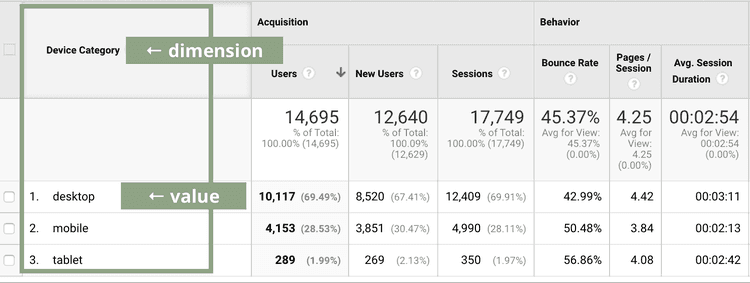A Comprehensive Guide to 'Secondary Dimensions' in Google Analytics: Insights Revealed
A Comprehensive Guide to 'Secondary Dimensions' in Google Analytics: Insights Revealed
Blog Article
Navigating the Depths of Additional Measurement in Google Analytics: An In-depth Exploration on Its Functionality
Secondary measurements, though relatively simple at very first look, harbor a riches of untapped possible waiting to be used. As we begin on this journey to discover the nuanced functionality of second dimensions, we will certainly reveal exactly how this feature can illuminate patterns, introduce connections, and ultimately pave the means for educated decision-making in the digital landscape (what is a “secondary dimension” in google analytics?).
Comprehending Second Measurements in Google Analytics

Recognizing how second dimensions work is important for leveraging the full power of Google Analytics. These measurements aid you address more intricate inquiries regarding user habits and the efficiency of your web site content and advertising and marketing efforts. For instance, you can make use of second dimensions to evaluate which browsers or devices are most generally made use of by site visitors that buy, or to compare the bounce prices of different traffic resources. By incorporating main metrics with second dimensions, you can get important insights that drive informed decision-making and optimization methods - what is a “secondary dimension” in google analytics?.
Leveraging Second Dimensions for Data Evaluation
Structure upon the fundamental understanding of exactly how additional measurements boost information evaluation in Google Analytics, the usage of these additional layers of information becomes vital in removing beneficial insights for notified decision-making and optimization techniques. By leveraging secondary measurements, experts can dig much deeper into the efficiency metrics by adding more context to the primary measurements, thus revealing hidden patterns and correlations that could not appear initially look. This deeper degree of evaluation makes it possible for services to much better comprehend user behavior, determine trends, and pinpoint areas for improvement.
Moreover, second measurements provide a more thorough sight of the information, allowing for division based upon various specifications such as demographics, gadgets, web traffic resources, and a lot more. This segmentation facilitates an extra granular analysis, enabling businesses to tailor their campaigns and methods to certain target market sectors for boosted targeting and personalization. Essentially, the critical use second measurements empowers organizations to make data-driven decisions that drive growth and success in the digital landscape.
Advanced Methods for Secondary Dimension Application
Checking out intricate techniques to harness the full capacity of secondary dimensions in Google Analytics raises the depth and class of information analysis for calculated decision-making. One sophisticated strategy for carrying out second dimensions is using customized dimensions. By specifying customized measurements, individuals can sector information additionally to get even more certain understandings into user actions, such as tracking communications with details elements on a web page or keeping track of the performance of a specific advertising and marketing project. One more innovative method is the use of regex (regular expressions) within second dimensions. Regex enables more adaptable and effective pattern matching, enabling customers to create complicated filters for data analysis. In addition, integrating additional dimensions with innovative sectors can provide a lot more granular understandings by using several layers of division to the data. This approach visit the website permits a deeper understanding of individual actions based on different criteria all at once. Applying these sophisticated strategies for additional dimensions in Google Analytics empowers users to conduct more advanced evaluation and make data-driven decisions with precision.
Interpreting Insights Via Second Measurements

When translating insights through second measurements, it is necessary to consider the context of the data and how various dimensions engage with each various other. Understanding which particular website traffic resources lead to higher conversion prices or identifying which devices individuals favor for making purchases can supply actionable weblink insights for maximizing advertising campaigns and enhancing total web site performance. By carefully examining the information with second measurements in mind, companies can make enlightened decisions that drive significant results and enhance their digital visibility.
Enhancing Performance With Additional Dimensions

One crucial way to maximize performance with secondary dimensions is by segmenting data more granularly. This enables you to separate specific factors that may be affecting your metrics and get a better understanding of what drives success or failing in your digital initiatives. For example, by incorporating additional measurements such as 'tool group' and 'landing page,' you can pinpoint which gadget types are most reliable for particular touchdown pages, allowing you to customize your techniques as necessary.
Moreover, utilizing additional dimensions can assist you recognize patterns, patterns, and connections that might not appear when assessing information with primary measurements alone. This much deeper level of evaluation can lead to even more educated decision-making and eventually boost the overall performance of your internet site or electronic advertising campaigns.
Conclusion
Finally, secondary measurements in Google Analytics play a critical function in improving data evaluation and giving much deeper understandings into internet site performance. By utilizing innovative techniques and analyzing the data properly, businesses can maximize their techniques and enhance general performance. Comprehending the functionality of additional measurements is crucial for making informed decisions and driving success in the digital landscape.
By leveraging second measurements, experts can dig deeper into the efficiency metrics by including even more context to the primary measurements, therefore uncovering covert patterns and connections that could click resources not be noticeable at initial look. One advanced strategy for carrying out additional dimensions is the use of personalized dimensions.Having grasped innovative methods like customized dimensions and regex for second dimension execution in Google Analytics, the next essential step is analyzing the important insights obtained via these sophisticated information division approaches. Interpreting understandings via second dimensions involves examining the connections in between the secondary and key measurements picked, revealing patterns, fads, and correlations that may not be instantly apparent when looking at the information in its totality.When translating understandings with additional measurements, it is necessary to consider the context of the data and exactly how different measurements engage with each other.
Report this page